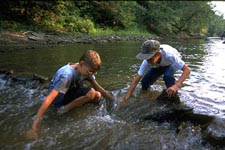Water Quality Standards
 The goal of the Clean Water Act (CWA) is "to restore and maintain the
chemical, physical, and biological integrity of the Nation's waters."
One step in achieving this goal is stated as an interim goal to attain
"water quality which provides for the protection of fish, shellfish, and
wildlife and provides for recreation in and on the water..." (This is
sometimes referred to as the fishable and swimmable goal.)
The goal of the Clean Water Act (CWA) is "to restore and maintain the
chemical, physical, and biological integrity of the Nation's waters."
One step in achieving this goal is stated as an interim goal to attain
"water quality which provides for the protection of fish, shellfish, and
wildlife and provides for recreation in and on the water..." (This is
sometimes referred to as the fishable and swimmable goal.)
 To achieve these goals, it is necessary to more specifically define what
is required for "integrity" or protection of aquatic life and
recreation. Therefore, section 303 of the CWA requires that standards
be developed for the Nations waters. In Illinois, the Illinois
Environmental Protection Agency (IEPA) is responsible for setting these
standards, with guidance from USEPA and input from the public.
To achieve these goals, it is necessary to more specifically define what
is required for "integrity" or protection of aquatic life and
recreation. Therefore, section 303 of the CWA requires that standards
be developed for the Nations waters. In Illinois, the Illinois
Environmental Protection Agency (IEPA) is responsible for setting these
standards, with guidance from USEPA and input from the public.
Regulations specify that these standards must include the following three components:
Designated uses are human and ecological water uses that are protected by the state. These uses dictate how the water will be protected. For example, waters used for public drinking water have different requirements from those that are not used for this purpose. In Illinois, the designated uses are General Use, Public and Food Processing Water Supply, Secondary Contact and Indigenous Aquatic Life, and Lake Michigan Basin. Criteria identify the minimum chemical, physical, and biological characteristics necessary to support uses. These include "numeric" criteria (for example, pH must always be between 6.5 and 9.0) and "narrative" criteria (for example, water shall be free from unnatural plant or algal growth). An antidegradation policy is required to protect all existing uses of all waters and to provide additional protection for high quality waters.
At least once every three years, IEPA is required to conduct a review of the standards and solicit public input on the standards.
For more information on water quality standards in Illinois, review the regulations regarding Illinois standards. USEPA also maintains a compilation of recommended criteria and many guidance documents that describe the science upon which those recommendations are based.